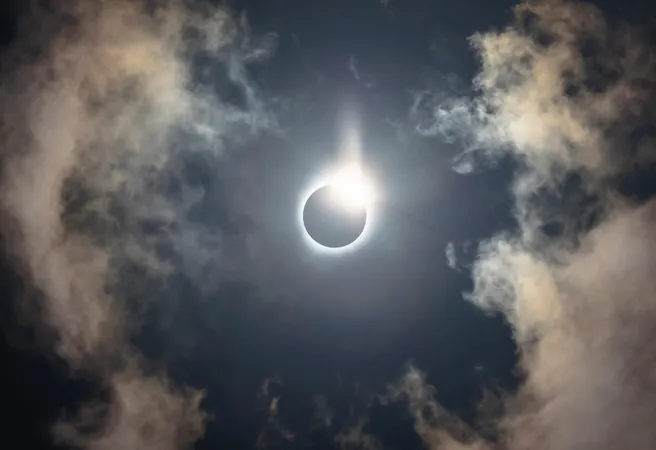
Is the Sun Creating Water on the Moon? The Shocking Discovery Explained!
2025-04-23
Author: Ken Lee
The Moon's Secret: Where Does Its Water Come From?
For decades, scientists have been captivated by the existence of water on the Moon. This intriguing element is critical not only for future lunar missions but also poses a tantalizing question: how did it get there? Recent hypotheses suggest that the answer may lie with our very own Sun.
The Solar Connection: A Game-Changing Theory
The concept is both simple and revolutionary: when charged particles from the Sun collide with the Moon's surface, they might trigger chemical reactions that create water. Excitingly, this theory has gained robust experimental backing!
NASA's Breakthrough: Experiments That Shake the Foundation
Researchers from NASA's Goddard Space Flight Center, in collaboration with other experts, have successfully demonstrated this process in a laboratory setting, utilizing one of the most sophisticated simulations of solar wind interaction with lunar dust ever conducted. This pivotal finding could alter the trajectory of NASA’s future lunar missions, particularly to the Moon's South Pole, where icy water may reside in dark, cold craters.
Li Hsia Yeo, a lead scientist on the study, expressed her excitement: "The fascinating aspect here is that with just the Moon's soil and hydrogen continuously emanating from the Sun, we could potentially generate water. It’s incredible to consider!"
The Power of Solar Wind: What Really Happens?
The Sun continuously unleashes a torrent of particles known as solar wind, moving at speeds exceeding one million miles per hour, primarily composed of hydrogen protons. While Earth’s magnetic field and atmosphere shield us from this onslaught, the Moon, lacking such protections, is completely vulnerable.
When solar wind protons bombard the Moon's dusty surface, or regolith, they pick up electrons and become hydrogen atoms. These atoms can then traverse the lunar surface, merging with oxygen found in minerals like silica, culminating in the formation of hydroxyl (OH) and occasionally actual water (H₂O). Evidence of both molecules has been detected just beneath the Moon's surface.
The Moon's Water Mystery: A Daily Dance
Interestingly, previous observations from spacecraft hinted at the possibility that solar wind is actively generating this water. A key indicator is the Moon’s water signature, which fluctuates throughout the lunar day—stronger in the cooler mornings, dwindling in the afternoon heat, and peaking again at night. This implies that the water isn’t static; it’s a dynamic entity constantly being created and lost.
Innovation in the Lab: A Groundbreaking Setup
To explore the solar wind theory, Yeo and her colleague Jason McLain designed an innovative laboratory setup that kept lunar samples sealed in a vacuum to prevent contamination from Earth’s moisture. Their meticulous efforts paid off, ultimately confirming the decades-old idea that the solar wind could indeed generate water.
Using lunar dust collected from Apollo 17 in 1972, the researchers baked the samples to eliminate any leftover water, then bombarded them with artificial solar wind, simulating around 80,000 years of lunar exposure.
Tracking the Signals: The Science Behind Water Formation
To monitor the molecular changes, the team employed a spectrometer, a device that analyzes how light interacts with materials. They identified a specific alteration in the light signal near the infrared range, indicative of water formation. While they couldn’t definitively state whether it was hydroxyl or water molecules, the evidence strongly points to both being produced.
Beyond Curiosity: Implications for Future Lunar Exploration
Understanding the origins and formation of water on the Moon goes beyond mere scientific intrigue; it could extensively affect how astronauts venture across the lunar surface. If solar wind indeed plays a role in water production, then lunar soil could turn into a valuable resource for drinking water, breathable oxygen, or even rocket propellant. With this groundbreaking research, the dream of utilizing lunar resources feels more attainable than ever.
The full study was published in the Journal of Geophysical Research: Planets. Stay tuned for more astonishing discoveries!

 Brasil (PT)
Brasil (PT)
 Canada (EN)
Canada (EN)
 Chile (ES)
Chile (ES)
 Česko (CS)
Česko (CS)
 대한민국 (KO)
대한민국 (KO)
 España (ES)
España (ES)
 France (FR)
France (FR)
 Hong Kong (EN)
Hong Kong (EN)
 Italia (IT)
Italia (IT)
 日本 (JA)
日本 (JA)
 Magyarország (HU)
Magyarország (HU)
 Norge (NO)
Norge (NO)
 Polska (PL)
Polska (PL)
 Schweiz (DE)
Schweiz (DE)
 Singapore (EN)
Singapore (EN)
 Sverige (SV)
Sverige (SV)
 Suomi (FI)
Suomi (FI)
 Türkiye (TR)
Türkiye (TR)
 الإمارات العربية المتحدة (AR)
الإمارات العربية المتحدة (AR)